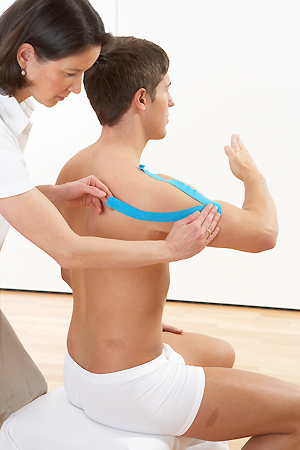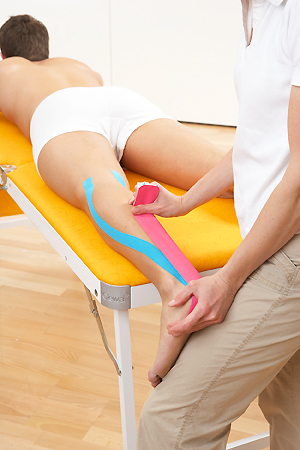
K-Taping Pro
The K-Taping Pro course is aimed to physiotherapists, sports physiotherapists, doctors, occupational therapists and alternative practitioners.
In the K-Taping Pro course, more than 70 techniques are used to present all the basic techniques and associated combination techniques for indications that are frequently used in your physiotherapy routine. In addition, the basic techniques for lymphatic techniques and the application of Crosstape are presented and learned in practical exercises.
By participating the K-Taping Pro course, you will get to know how to use the K-Taping Therapy for many diseases with following techniques:
- Muscle techniques
- Ligament techniques
- Correction techniques
- Fascia techniques
- Lymphatic techniques
K-Taping courses have a high practical share in which the participants practice the techniques at each other. The learning control takes place during the practical exercises by our experienced instructors. This will enable you to include the K-Taping Therapy in your treatment right after the course. The high-quality and detailed coloured course book contains all presented techniques and indications and serves you after the course as extensive practical handbook.
Requirement
The course requires anatomical and therapeutic knowledge. Participants should therefore have a therapeutic or medical education. Students undergoing training in therapeutic and medical careers may also attend the course.
The course fee includes the extensive colour script as well as the K-Tape and Crosstape for the practical exercises.
Recommendation
It is recommended to wear comfortable clothes for dressing and undressing during the practical exercises as well as to bring a towel to the underlay.
Course content
Part 1Theory
Basics and effects of K-Taping therapy
The basic techniques
Application of basic techniques, indication related combination rules, CROSSTAPE, lymphatic techniques
Part 2Muscle techniques
General basics of muscular techniques
Muscle techniques
Upper extremities:
M. trapezius, M. deltoideus, M. biceps brachii, M. triceps brachii, M. supraspinatus, M.
infraspinatus, M. extensor carpi radialis longus
Torso:
M. pectoralis minor, M. pectoralis major, M. rectus abdominis, M. transversus abdominis, M. obliquus
internus & externus abdominis, M. iliacus, M. quadratus lumborum
Lower extremities:
M. adductor longus, M. rectus femoris, M. biceps femoris, M. semimembranosus, M. glutaues maximus,
M. tibialis anterior, M. extensor hallucis longus, Erector spinae
Part 3Ligament attachment
General basics of a ligament attachment
Ligament attachment
Collateral ligaments knee, patellar tendon, Achilles tendon, spacetape pain point, spacetape trigger point
Part 4correction techniques
General principles of a functional correction technique
Functional correction
Patellar correction, shoulder correction, spine correction, combinations
Part 5Fascia correction techniques
General principles of fascia correction
Fascia correction
Tractus iliotibialis, Epicondylitis, Biceps tendon irritation, Pes anserinus irritation, Muscular rupture, Sinusitis / headache, Hallux valgus, Anterior shoulder instability
Part 6Indication techniques
Indication techniques
Tinnitus, migraine, impingement syndrome, thoracic outlet syndrome, whiplash, respiratory support, scoliosis, lumbar spine syndrome, temporomandibular joint, facial palsy, carpal tunnel syndrome, rhizarthrosis, finger / hand erection, finger rotation, finger contusion, wrist stabilization, hip problems, knee osteoarthritis, achillodynia, ankle distorsion, sprain – / flatfoot, micturition, menstrual disorders, uterine hypotension, constipation, abdominal spiral, irritable bowel syndrome, rib fracture / bruise, arm / leg rotation, scar tape.
Part 7Nerve techniques
General basics of a nerve technique and nerve testing
Nerve techniques
Nervus medianus, Nervus radialis, Nervus ulnaris, Nervus ischiadicus
Part 8Lymphatic techniques
General basics of lymphatic techniques
Lymphatic techniques
Joint drainage shoulder, knee joint drainage, drainage thigh, drainage face, drainage abdomen, leg spiral, drainage lower leg, drainage forearm, fibrosis / hematoma.
Part 9CROSSTAPING
Basics of CROSSTAPING
Application of CROSSTAPING using various examples
Part 10Course evaluation
Course evaluation
20
9:00 AM – 6:00 PM
Certificate
300


